Anyi Rao
Taming Flow-based I2V Models for Creative Video Editing
Sep 26, 2025Abstract:Although image editing techniques have advanced significantly, video editing, which aims to manipulate videos according to user intent, remains an emerging challenge. Most existing image-conditioned video editing methods either require inversion with model-specific design or need extensive optimization, limiting their capability of leveraging up-to-date image-to-video (I2V) models to transfer the editing capability of image editing models to the video domain. To this end, we propose IF-V2V, an Inversion-Free method that can adapt off-the-shelf flow-matching-based I2V models for video editing without significant computational overhead. To circumvent inversion, we devise Vector Field Rectification with Sample Deviation to incorporate information from the source video into the denoising process by introducing a deviation term into the denoising vector field. To further ensure consistency with the source video in a model-agnostic way, we introduce Structure-and-Motion-Preserving Initialization to generate motion-aware temporally correlated noise with structural information embedded. We also present a Deviation Caching mechanism to minimize the additional computational cost for denoising vector rectification without significantly impacting editing quality. Evaluations demonstrate that our method achieves superior editing quality and consistency over existing approaches, offering a lightweight plug-and-play solution to realize visual creativity.
Light of Normals: Unified Feature Representation for Universal Photometric Stereo
Jun 24, 2025Abstract:Universal photometric stereo (PS) aims to recover high-quality surface normals from objects under arbitrary lighting conditions without relying on specific illumination models. Despite recent advances such as SDM-UniPS and Uni MS-PS, two fundamental challenges persist: 1) the deep coupling between varying illumination and surface normal features, where ambiguity in observed intensity makes it difficult to determine whether brightness variations stem from lighting changes or surface orientation; and 2) the preservation of high-frequency geometric details in complex surfaces, where intricate geometries create self-shadowing, inter-reflections, and subtle normal variations that conventional feature processing operations struggle to capture accurately.
ProFashion: Prototype-guided Fashion Video Generation with Multiple Reference Images
May 10, 2025Abstract:Fashion video generation aims to synthesize temporally consistent videos from reference images of a designated character. Despite significant progress, existing diffusion-based methods only support a single reference image as input, severely limiting their capability to generate view-consistent fashion videos, especially when there are different patterns on the clothes from different perspectives. Moreover, the widely adopted motion module does not sufficiently model human body movement, leading to sub-optimal spatiotemporal consistency. To address these issues, we propose ProFashion, a fashion video generation framework leveraging multiple reference images to achieve improved view consistency and temporal coherency. To effectively leverage features from multiple reference images while maintaining a reasonable computational cost, we devise a Pose-aware Prototype Aggregator, which selects and aggregates global and fine-grained reference features according to pose information to form frame-wise prototypes, which serve as guidance in the denoising process. To further enhance motion consistency, we introduce a Flow-enhanced Prototype Instantiator, which exploits the human keypoint motion flow to guide an extra spatiotemporal attention process in the denoiser. To demonstrate the effectiveness of ProFashion, we extensively evaluate our method on the MRFashion-7K dataset we collected from the Internet. ProFashion also outperforms previous methods on the UBC Fashion dataset.
Generative AI for Film Creation: A Survey of Recent Advances
Apr 11, 2025

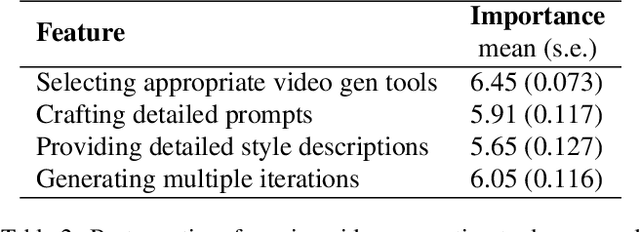
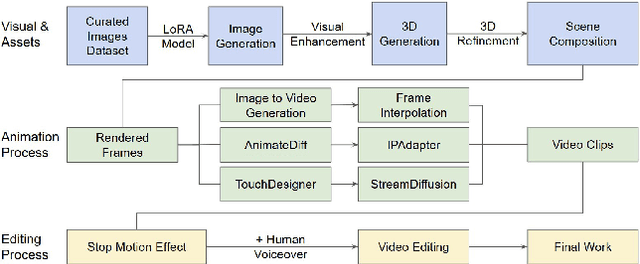
Abstract:Generative AI (GenAI) is transforming filmmaking, equipping artists with tools like text-to-image and image-to-video diffusion, neural radiance fields, avatar generation, and 3D synthesis. This paper examines the adoption of these technologies in filmmaking, analyzing workflows from recent AI-driven films to understand how GenAI contributes to character creation, aesthetic styling, and narration. We explore key strategies for maintaining character consistency, achieving stylistic coherence, and ensuring motion continuity. Additionally, we highlight emerging trends such as the growing use of 3D generation and the integration of real footage with AI-generated elements. Beyond technical advancements, we examine how GenAI is enabling new artistic expressions, from generating hard-to-shoot footage to dreamlike diffusion-based morphing effects, abstract visuals, and unworldly objects. We also gather artists' feedback on challenges and desired improvements, including consistency, controllability, fine-grained editing, and motion refinement. Our study provides insights into the evolving intersection of AI and filmmaking, offering a roadmap for researchers and artists navigating this rapidly expanding field.
Simulating the Real World: A Unified Survey of Multimodal Generative Models
Mar 06, 2025



Abstract:Understanding and replicating the real world is a critical challenge in Artificial General Intelligence (AGI) research. To achieve this, many existing approaches, such as world models, aim to capture the fundamental principles governing the physical world, enabling more accurate simulations and meaningful interactions. However, current methods often treat different modalities, including 2D (images), videos, 3D, and 4D representations, as independent domains, overlooking their interdependencies. Additionally, these methods typically focus on isolated dimensions of reality without systematically integrating their connections. In this survey, we present a unified survey for multimodal generative models that investigate the progression of data dimensionality in real-world simulation. Specifically, this survey starts from 2D generation (appearance), then moves to video (appearance+dynamics) and 3D generation (appearance+geometry), and finally culminates in 4D generation that integrate all dimensions. To the best of our knowledge, this is the first attempt to systematically unify the study of 2D, video, 3D and 4D generation within a single framework. To guide future research, we provide a comprehensive review of datasets, evaluation metrics and future directions, and fostering insights for newcomers. This survey serves as a bridge to advance the study of multimodal generative models and real-world simulation within a unified framework.
Light-A-Video: Training-free Video Relighting via Progressive Light Fusion
Feb 12, 2025
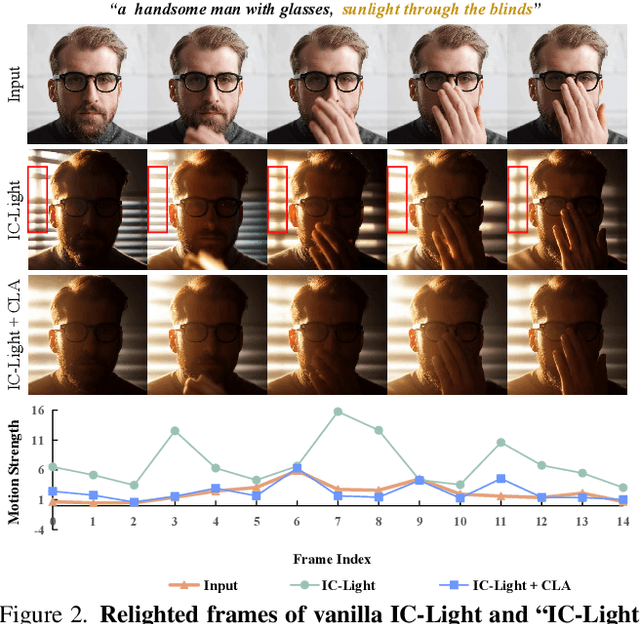
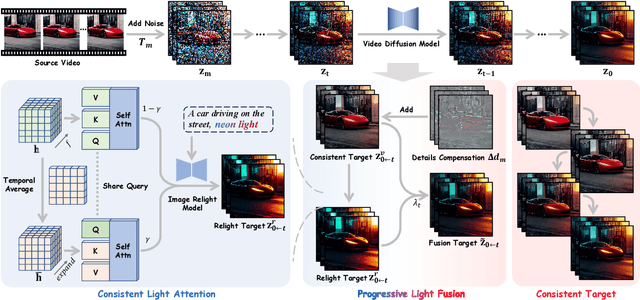
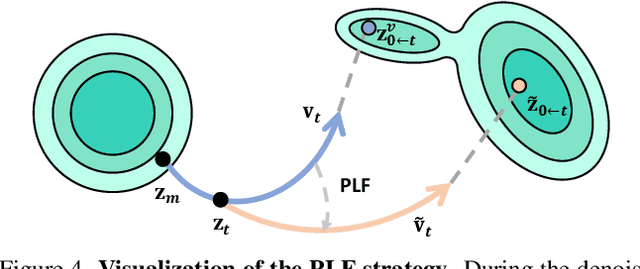
Abstract:Recent advancements in image relighting models, driven by large-scale datasets and pre-trained diffusion models, have enabled the imposition of consistent lighting. However, video relighting still lags, primarily due to the excessive training costs and the scarcity of diverse, high-quality video relighting datasets. A simple application of image relighting models on a frame-by-frame basis leads to several issues: lighting source inconsistency and relighted appearance inconsistency, resulting in flickers in the generated videos. In this work, we propose Light-A-Video, a training-free approach to achieve temporally smooth video relighting. Adapted from image relighting models, Light-A-Video introduces two key techniques to enhance lighting consistency. First, we design a Consistent Light Attention (CLA) module, which enhances cross-frame interactions within the self-attention layers to stabilize the generation of the background lighting source. Second, leveraging the physical principle of light transport independence, we apply linear blending between the source video's appearance and the relighted appearance, using a Progressive Light Fusion (PLF) strategy to ensure smooth temporal transitions in illumination. Experiments show that Light-A-Video improves the temporal consistency of relighted video while maintaining the image quality, ensuring coherent lighting transitions across frames. Project page: https://bujiazi.github.io/light-a-video.github.io/.
ScriptViz: A Visualization Tool to Aid Scriptwriting based on a Large Movie Database
Oct 04, 2024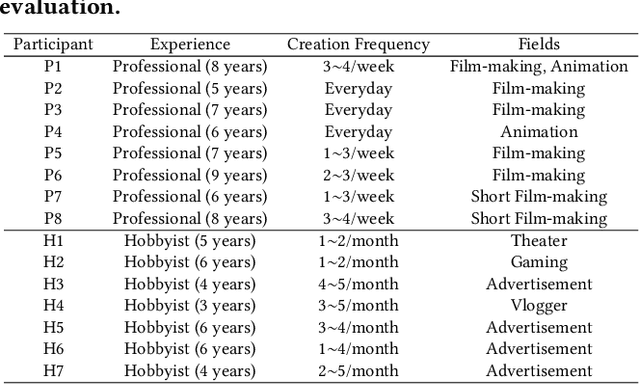
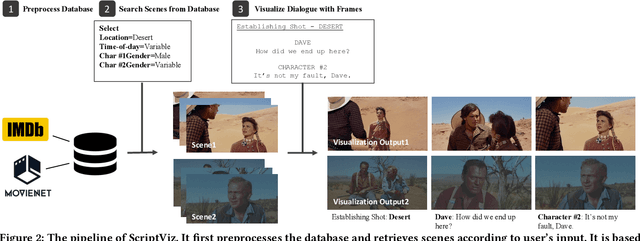


Abstract:Scriptwriters usually rely on their mental visualization to create a vivid story by using their imagination to see, feel, and experience the scenes they are writing. Besides mental visualization, they often refer to existing images or scenes in movies and analyze the visual elements to create a certain mood or atmosphere. In this paper, we develop ScriptViz to provide external visualization based on a large movie database for the screenwriting process. It retrieves reference visuals on the fly based on scripts' text and dialogue from a large movie database. The tool provides two types of control on visual elements that enable writers to 1) see exactly what they want with fixed visual elements and 2) see variances in uncertain elements. User evaluation among 15 scriptwriters shows that ScriptViz is able to present scriptwriters with consistent yet diverse visual possibilities, aligning closely with their scripts and helping their creation.
CinePreGen: Camera Controllable Video Previsualization via Engine-powered Diffusion
Aug 30, 2024Abstract:With advancements in video generative AI models (e.g., SORA), creators are increasingly using these techniques to enhance video previsualization. However, they face challenges with incomplete and mismatched AI workflows. Existing methods mainly rely on text descriptions and struggle with camera placement, a key component of previsualization. To address these issues, we introduce CinePreGen, a visual previsualization system enhanced with engine-powered diffusion. It features a novel camera and storyboard interface that offers dynamic control, from global to local camera adjustments. This is combined with a user-friendly AI rendering workflow, which aims to achieve consistent results through multi-masked IP-Adapter and engine simulation guidelines. In our comprehensive evaluation study, we demonstrate that our system reduces development viscosity (i.e., the complexity and challenges in the development process), meets users' needs for extensive control and iteration in the design process, and outperforms other AI video production workflows in cinematic camera movement, as shown by our experiments and a within-subjects user study. With its intuitive camera controls and realistic rendering of camera motion, CinePreGen shows great potential for improving video production for both individual creators and industry professionals.
Cinematic Behavior Transfer via NeRF-based Differentiable Filming
Nov 29, 2023Abstract:In the evolving landscape of digital media and video production, the precise manipulation and reproduction of visual elements like camera movements and character actions are highly desired. Existing SLAM methods face limitations in dynamic scenes and human pose estimation often focuses on 2D projections, neglecting 3D statuses. To address these issues, we first introduce a reverse filming behavior estimation technique. It optimizes camera trajectories by leveraging NeRF as a differentiable renderer and refining SMPL tracks. We then introduce a cinematic transfer pipeline that is able to transfer various shot types to a new 2D video or a 3D virtual environment. The incorporation of 3D engine workflow enables superior rendering and control abilities, which also achieves a higher rating in the user study.
SparseCtrl: Adding Sparse Controls to Text-to-Video Diffusion Models
Nov 28, 2023


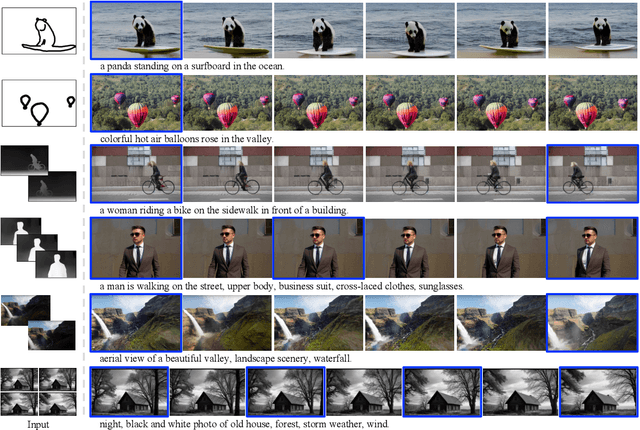
Abstract:The development of text-to-video (T2V), i.e., generating videos with a given text prompt, has been significantly advanced in recent years. However, relying solely on text prompts often results in ambiguous frame composition due to spatial uncertainty. The research community thus leverages the dense structure signals, e.g., per-frame depth/edge sequences, to enhance controllability, whose collection accordingly increases the burden of inference. In this work, we present SparseCtrl to enable flexible structure control with temporally sparse signals, requiring only one or a few inputs, as shown in Figure 1. It incorporates an additional condition encoder to process these sparse signals while leaving the pre-trained T2V model untouched. The proposed approach is compatible with various modalities, including sketches, depth maps, and RGB images, providing more practical control for video generation and promoting applications such as storyboarding, depth rendering, keyframe animation, and interpolation. Extensive experiments demonstrate the generalization of SparseCtrl on both original and personalized T2V generators. Codes and models will be publicly available at https://guoyww.github.io/projects/SparseCtrl .
 Add to Chrome
Add to Chrome Add to Firefox
Add to Firefox Add to Edge
Add to Edge